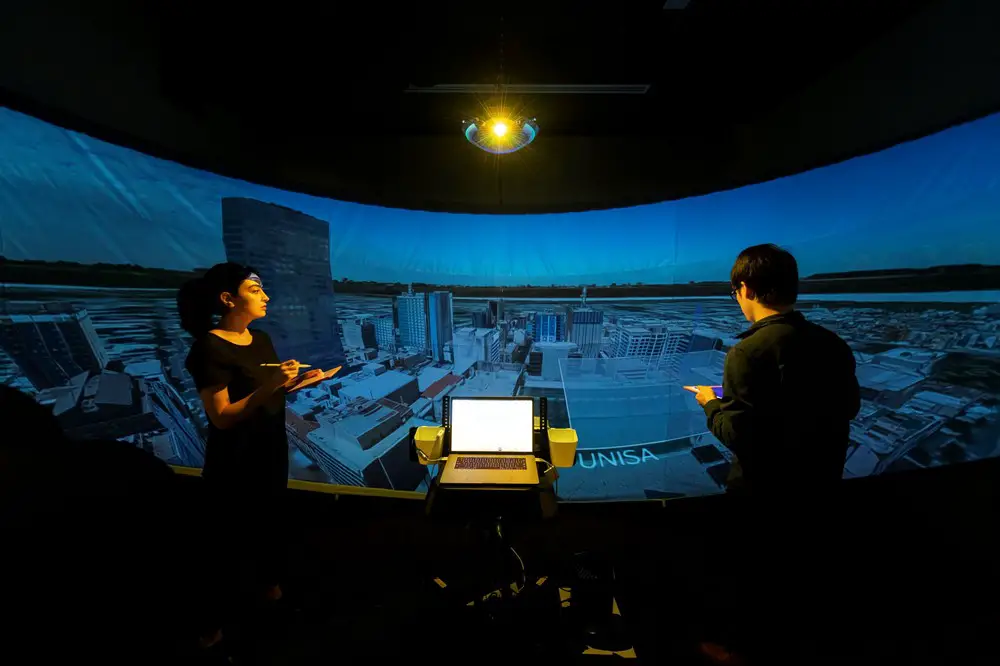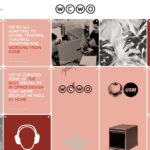Virtual reality + augmented reality design advice, Architects Hames Sharley VR Office guide
Virtual Reality + Augmented Reality Affect Design
24 June 2020
Architecture in an Age of Augmented Reality
How Virtual Reality (VR) and Augmented Reality (AR) will shape the future of built environments
How Virtual Reality + Augmented Reality Affect Architecture
To those outside of the industry, the idea of taking a virtual tour of a new building before it’s even been constructed, every detail brought to life by wearing VR goggles, might sound like science fiction. But for designers, these futuristic technologies are becoming par for the course, rapidly transforming architecture as we know it.
And the technologies continue to advance at lightning speed. Right now, Hames Sharley’s South Australian Studio Leader and Director, Leon Gouws has partnered with Professor Ning Gu from the Australian Research Centre for Interactive and Virtual Environments (IVE) to explore innovative ways to integrate VR and AR into both practice and education.
Australian Research Centre for Interactive and Virtual Environments (IVE):
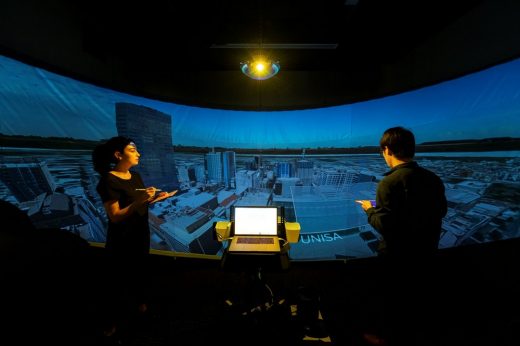
The pair are exploring the application of a new VR infrastructure recently acquired at IVE called Hyve-3D; a room-sized large-scale immersive design and visualisation system which will allow the creation and viewing of 3D models and sketches both co-located and remotely. This cutting-edge technology is a major breakthrough in 3D design as removes the need to wear VR goggles, enabling everyone in the room to immerse in the virtual environment and directly interact through 3D sketching.
This is such an exciting partnership, that we decided to sit down with Professor Ning Gu to learn more about IVE and how AR and VR is influencing the world of architecture.
The Australian Research Centre for Interactive and Virtual Environments
“The Australian Research Centre for Interactive and Virtual Environments (IVE) is a world leader in AR and VR. With its home base at the University of South Australia (UniSA), it is an interdisciplinary research centre aligning computer science, engineering, art, architecture, and design,” Professor Ning Gu told us. “IVE was created as a response to the challenge of increased demand for AR and VR technologies globally.”
Professor Ning Gu is the Deputy Director of IVE and Professor in Architecture at UniSA. He works as part of a team of researchers – led by Director Professor Bruce Thomas – who are pioneers in AR and VR research, including wearable computing, interface design, empathic computing, 3D visualisation, perception, and telepresence.
“My role at IVE is to foster interdisciplinary collaboration between science and engineering, and, art and design, applying these advanced technologies to explore opportunities in design and the built environment.”
AR in design
Architects are already very familiar with Computer-Aided Design (CAD) tools such as Building Information Modelling (BIM), parametric design, and various specialist simulation, analysis and management tools. These are typical VR technologies as they allow architectural design to be virtually represented and realised before construction. But augmented reality takes things to the next level.
“AR goes one step further to allow these visualisations which are virtual to be inserted into the physical reality, hence, it is augmented,” Professor Ning explained.
“For example, we can now conduct a design review meeting on the actual development site where designs can be examined and experienced in real scale. We can also virtually see through the wall surfaces to reveal the services behind for clash detection, or live-feed data of indoor environmental indicators to be provided to the physical space when testing different layout plans. It’s extremely beneficial and can significantly improve design quality and efficiency in the long-term.”
IVE Cutting edge research
IVE works on a range of projects focusing on the built environment sector, generously supported by various government and industry funding.
“Our projects range from augmenting BIM model visualisation and analytics, to enhancing digital collaborative practices in the housing sector, to visualising big data for supporting planning and design-decision making, and to digitisation and virtual story-telling of aboriginal built heritage,” said Professor Gu.
“The advanced research conducted at IVE will provide valuable resources and market advantages for architectural practices to continue to innovate and grow.”
Taking advantage of government funding dedicated to support innovation through research, the IVE’s industry partnerships are leveraged through accessing major government investments promoting partnerships between researchers and business, industry, community organisations.
Professor Gu says industry engagement is key to IVE as it allows the research to be well-grounded and solve real-world problems.
IVE has partnered with various industries to develop cutting-edge AR and VR tools, to facilitate the adoption of the technology, and to conduct longitudinal studies to explore the technological impacts of AR and VR. This advancement is all possible through funding such as the Australian Research Council (ARC) Linkage Program, Cooperative Research Centred (CRC) Grants, and other industry-funded scholarships on research students and fellows.
Driving future innovation
UniSA has a long history of collaboration with Hames Sharley, as Professor Gu elaborated, “In my other role as Professor in Architecture, I am acutely aware of the generous support from Hames Sharley to our Architecture Program and our graduates through the annual design prizes, reviews/exhibitions and design crits, of which I am deeply appreciative. And now, I couldn’t be more excited that our collaboration is extending into research.”
Professor Gu believes the future development of AR and VR are predominantly in the following two areas,
“Firstly, we’ll see the continuing advancement of the interfaces to allow easier access and more intuitive interaction. In other words, the realities of virtual and physical are truly merged.”
“Secondly, we’ll see the enhancement of the capabilities in AR and VR environments, supporting with the advancement and integration of Artificial Intelligence (AI), data analytics and citizen science.”
Professor Gu believes this will allow AR and VR to evolve from being simply a visualisation and simulation technology into a new and more powerful technology for design, decision making and for communication and engagement.
“The communication and engagement aspects are especially impactful, not only for the design professionals but for the broader community, which will keep us connected and communicate more effectively beyond many physical constraints.”
These future developments of AR and VR will have significant impacts on improving the design of the built environment. Further, the merged or mixed realities will require us to re-consider the definition of the “environment” we live in. With more and more people spending increasing amount of time in mixed realities, as we are all currently experiencing. What is the role of architects? How can we contribute to the design of this holistic environment across both realities?
Professor Gu said, “This is a challenge and opportunity for us all.”
Many thanks to co-sponsors SAAB and the South Australian Government for making this research possible.
Virtual Reality + Augmented Reality design information and image from Hames Sharley Architects Australia
Hames Sharley Architects
Hames Sharley – How COVID-19 changes the way we work
Show everyone who’s boss
Hames Sharley employees during a Zoom meeting:
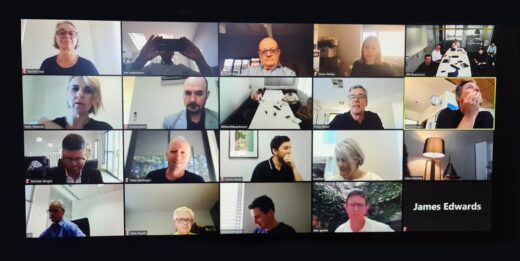
Hames Sharley’s response to COVID-19 virus.
Forrest Chase Perth Shopping Centre by Hames Sharley Architecture, Urban & Interior Design:
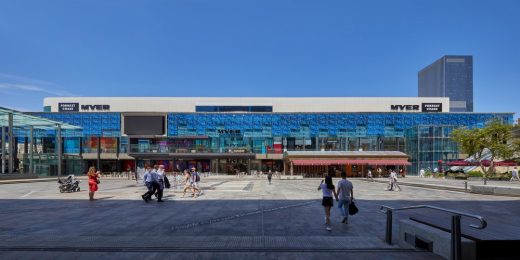
photograph : Douglas Mark Black
Architecture in 2020
RMJM Database for Quarantined Architects
Coronavirus on the property market
Comments / photos for the Virtual Reality + Augmented Reality Design page welcome

